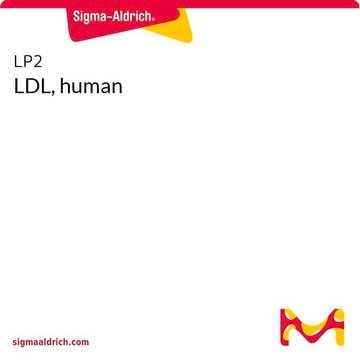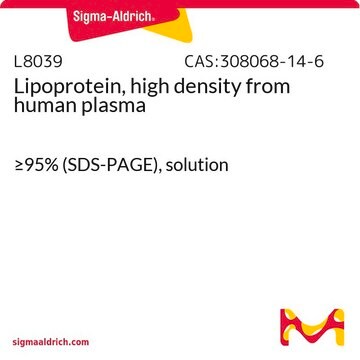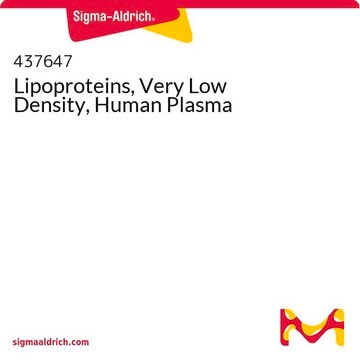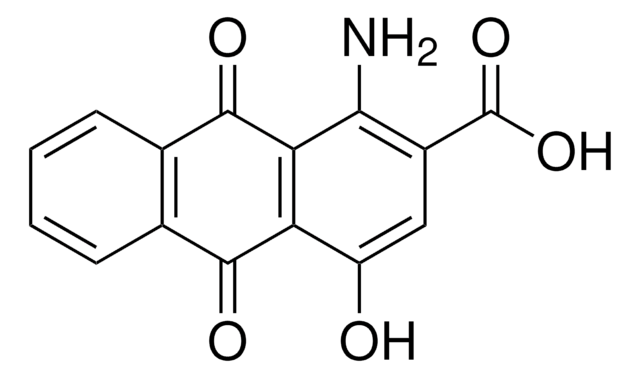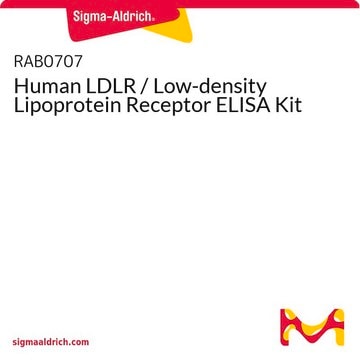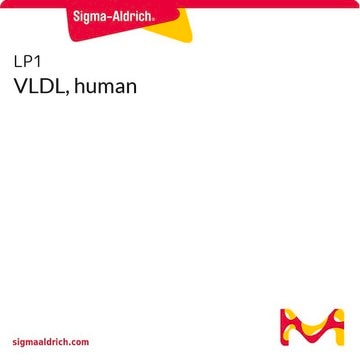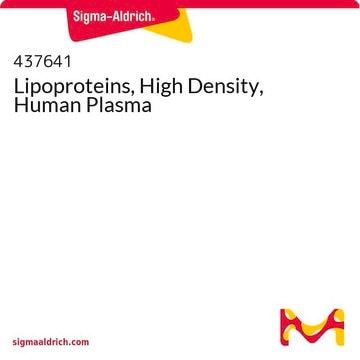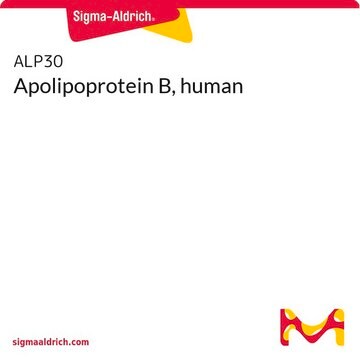SAE0053
Lipoprotein, low density from human plasma, solution
Sinônimo(s):
LDL, Low density lipoprotein, beta-lipoprotein
Faça loginpara ver os preços organizacionais e de contrato
About This Item
Código UNSPSC:
12352202
NACRES:
NA.61
Produtos recomendados
Ações bioquímicas/fisiológicas
Low-density lipoprotein (LDL) is a lipoprotein that carries cholesterol throughout the body via blood circulation. LDL has a role in dispositioning cholesterol to tissues and organs of the body. Colloquially deemed as the "bad cholesterol", having high levels of LDL can lead to plaque formation in arteries.
LDL and HDL transport both dietary and endogenous cholesterol in the plasma. LDL is the main transporter of cholesterol and cholesteryl esters, and makes up more than half of the total lipoprotein in plasma. LDL is absorbed by the liver and other tissues via receptor mediated endocytosis. The cytoplasmic domain of the LDL receptor facilitates the formation of coated pits; receptor-rich regions of the membrane. The ligand binding domain of the receptor recognizes apo-B100 on LDL, resulting in the formation of a clathrin-coated vesicle. ATP-dependent proton pumps lower the pH inside the vesicle, resulting in dissociation of LDL from its receptor. After loss of the clathrin coat, the vesicles fuse with lysozomes, resulting in peptide and cholesteryl ester enzymatic hydrolysis. The LDL receptor can be recycled to the cell membrane. Insulin, tri-iodothyronine and dexamethasome have shown to be involved with the regulation of LDL receptor mediated uptake
LDL and HDL transport both dietary and endogenous cholesterol in the plasma. LDL is the main transporter of cholesterol and cholesteryl esters, and makes up more than half of the total lipoprotein in plasma. LDL is absorbed by the liver and other tissues via receptor mediated endocytosis. The cytoplasmic domain of the LDL receptor facilitates the formation of coated pits; receptor-rich regions of the membrane. The ligand binding domain of the receptor recognizes apo-B100 on LDL, resulting in the formation of a clathrin-coated vesicle. ATP-dependent proton pumps lower the pH inside the vesicle, resulting in dissociation of LDL from its receptor. After loss of the clathrin coat, the vesicles fuse with lysozomes, resulting in peptide and cholesteryl ester enzymatic hydrolysis. The LDL receptor can be recycled to the cell membrane. Insulin, tri-iodothyronine and dexamethasome have shown to be involved with the regulation of LDL receptor mediated uptake
Exoneração de responsabilidade
RESEARCH USE ONLY. This product is regulated in France when intended to be used for scientific purposes, including for import and export activities (Article L 1211-1 paragraph 2 of the Public Health Code). The purchaser (i.e. enduser) is required to obtain an import authorization from the France Ministry of Research referred in the Article L1245-5-1 II. of Public Health Code. By ordering this product, you are confirming that you have obtained the proper import authorization.
Código de classe de armazenamento
10 - Combustible liquids
Classe de risco de água (WGK)
WGK 3
Ponto de fulgor (°F)
Not applicable
Ponto de fulgor (°C)
Not applicable
Certificados de análise (COA)
Busque Certificados de análise (COA) digitando o Número do Lote do produto. Os números de lote e remessa podem ser encontrados no rótulo de um produto após a palavra “Lot” ou “Batch”.
Já possui este produto?
Encontre a documentação dos produtos que você adquiriu recentemente na biblioteca de documentos.
Os clientes também visualizaram
Nossa equipe de cientistas tem experiência em todas as áreas de pesquisa, incluindo Life Sciences, ciência de materiais, síntese química, cromatografia, química analítica e muitas outras.
Entre em contato com a assistência técnica
